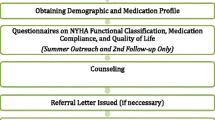Abstract
Objective The purpose of this study is to investigate the effectiveness of introducing clinical pharmacy services in achieving goal lipid profile in dyslipidemia patients in North of Jordan. Setting the study was carried out in a primary care facility in North of Jordan. Methods: One hundred fifty two dyslipidemia patients were randomized into intervention and control groups and followed for 6 months period. Intervention group patients were followed intensively by a clinical pharmacist who worked closely with physicians in controlling lipid profiles according to the third edition of recommendations by The National Cholesterol Education Program Adult Treatment Panel, control group patients were provided with standard medical care. Main outcome measure percent of patients at their low density lipoprotein cholesterol target in the intervention group compared to percent of patients at their low density lipoprotein cholesterol target in the control group by the end of the study. Results: One hundred twenty five patients completed the study duration. After 6 months, 94.5% of intervention group patients and 71.2 % of control group patients reached their goal low density lipoprotein cholesterol levels (P value < 0.001, Pearson Chi-Square test) compared to 24.7 and 28.8% respectively at baseline. Majority of pharmacist recommendations (90.4%) were followed by physicians and overall lipid lowering agents use was increased to 91.8% in intervention group patients and 86.5% in control group patients compared to 69.9 and 78.8% respectively at baseline. Conclusion: Implementing clinical pharmacy services in Jordan has improved the lipid profiles of dyslipidemic patients.

Similar content being viewed by others
References
Haung PL. A comprehensive definition for metabolic syndrome. Dis Model Mech. 2006;2(5–6):231–7.
Hammoudeh AJ, Izraiq M, Al-Mousa E, Al-Tarawneh H, Elharassis A, Mahadeen Z, et al. Serum lipid profiles with and without CAD: Jordan hyperlipidaemia and related targets study (JoHARTS-1). East Mediterr Health J. 2008;14(1):24–32.
Geller JC, Cassens S, Brosz M, Keil U, Bernarding J, Kropf S, et al. Achievement of guideline-defined treatment goals in primary care: the German coronary risk management (CoRiMa) study. Eur Heart J. 2007;28:3051–8.
Bozovich M, Rubino CM, Edmunds J. Effect of a clinical pharmacist-managed lipid clinic on achieving national cholesterol education program low density lipoprotein goals. Pharmacotherapy. 2000;20(11):1375–83.
Carter BL, Malone DC, Billups SJ, Valuck RJ, Barnette DJ, Sintek CD, et al. Interpreting the findings of the IMPROVE study. Am J Health Sys Pharm. 2001;58(14):1330–7.
Yates S, Annis L, Pippins J, Walden S. Does a lipid clinic increase compliance with cholesterol education program treatment guidelines? Report of a case-matched controlled study. South Med J. 2001;94:907–9.
Mazzolini TA, Irons BK, Schell EC, Seifert CF. Lipid levels and use of lipid-lowering drugs for patients in pharmacist-managed lipid clinics versus usual care in a 2 VA medical centers. J Manag Care Pharm. 2005;11(9):763–71.
Till LT Jr, Voris JC, Horst JB. Assessment of clinical pharmacist management of lipid-lowering therapy in a primary care setting. J Manag Care Pharm. 2003;9(3):269–73.
Lee VWY, Fan CSY, Li AWM, Chau ACY. Clinical impact of a pharmacist co-managed programme on hyperlipidaemia management in Hong Kong. J Clinic Pharm Therap. 2009;34:407–14.
Phumipamorn S, Pongwecharak J, Soorapan S, Pattharachayakul S. Effects of the pharmacist’s input on glycaemic control and cardiovascular risks in Muslims diabetes. Prim Care Diabetes. 2008;2(1):31–7. Abstract.
Al-Wazaify M, Albsoul-Younes A. Pharmacy in Jordan. Am J of Health Sys Pharm. 2005;62(23):2548–51.
McDonough RP, Doucette WR. Developing collaborative working relationships between pharmacists and physicians. J Am Pharm Assoc. 2001;41(5):682–92.
Expert panel on detection, evaluation, and treatment of high blood cholesterol in adults. Executive summary of the third report of the National Cholesterol Education Program (NCEP) expert panel on detection, evaluation and treatment of high blood cholesterol in adults (Adult Treatment Panel III). JAMA. 2001;285:2486–97.
Tahaineh LM, Wazaify M, Albsoul-Younes A, Khader Y, Zaidan M. Perceptions, experiences, and expectations of physicians in hospital settings in Jordan regarding the role of the pharmacist. Res Social Adm Pharm. 2009;5(1):63–70.
Ali F, Laurin M-Y, Lariviere C, Tremblay D, Cloutier D. The effect of pharmacist intervention and patient education on lipid-lowering medication compliance and plasma cholesterol levels. Can J Clin Pharmacol. 2003;10:101–6.
Bogden PE, Koontz LM, Williamson P, Abbott RD. The physician and pharmacist team. An effective approach to cholesterol reduction. J Gen Intern Med. 1997;12:158–64.
Chiu CC, Wu SS, Lee PY, Huang YC, Tan TY, Chang KC. Control of modifiable risk factors in ischemic stroke outpatients by pharmacist intervention: an equal allocation stratified randomized study. J Clinic Pharm Therap. 2008;33:529–35.
Davidson MH, Ose L, Frohlich J, Scott RS, Dujovne CA, Escobar ID, et al. Differential effects of simvastatin and atorvastatin on high density lipoprotein cholesterol and apolipoprotein A-1 are consistent across hypercholesterolemic patient subgroups. Clin Cardiol. 2003;26:509–14.
Bevilacqua M, Guazzini B, Righini V, Barella M, Toscano R, Chebat E. Metabolic effects of fluvastatin extended release 80 mg and atorvastatin 20 mg in patients with type 2 diabetes mellitus and low serum high-density lipoprotein cholesterol levels: a 4-month, prospective, open label, randomized, blinded-end point (Probe) trial. Curr Ther Res. 2004;65(4):330–44.
Acknowledgment
The authors would like to acknowledge all members of the Health Center of Jordan University of Science and Technology in Irbid for their assistance and cooperation. We also would like to thank Neda Radwan, RPh for her help in statistical analysis.
Funding
This work was supported by a grant from the Deanship of Research, Jordan University of Science and Technology, Irbid, Jordan.
Conflicts of interest
None.
Author information
Authors and Affiliations
Corresponding author
Rights and permissions
About this article
Cite this article
Tahaineh, L., Albsoul-Younes, A., Al-Ashqar, E. et al. The role of clinical pharmacist on lipid control in dyslipidemic patients in North of Jordan. Int J Clin Pharm 33, 229–236 (2011). https://doi.org/10.1007/s11096-011-9479-0
Received:
Accepted:
Published:
Issue Date:
DOI: https://doi.org/10.1007/s11096-011-9479-0




